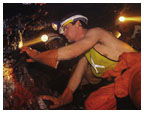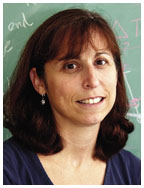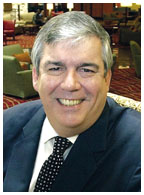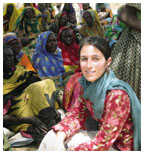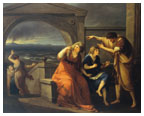October 20, 2004: Notebook
Searching for life below the surface
Professor and alumnus win “genius grants”
More than a dozen join politics faculty
Finding made in student’s death
Microbial samples gathered by Professor Tullis Onstott *81 in a South African gold mine may hold clues about how life could survive in the subsurface of Mars. (Courtesy Tullis Onstott *81) |
Breaking
ground: Astrobiology
Searching
for life below the surface
When the NASA rovers Spirit and Opportunity began exploring Mars in January, they transmitted views of a stunning but desolate landscape. Life on the surface of the planet, if it ever existed, appears long gone. But according to geology professor Tullis Onstott *81, there could be signs of life in the crust of the red planet. With support from NASA and the Indiana-Princeton-Tennessee Astrobiology Institute (IPTAI), Onstott and his colleagues are devoting the next 10 years to designing ways to search for microorganisms in the subsurface of Mars.
NASA’s interest in the project stems from its belief that life beneath the surface can survive for long periods of time without photosynthesis, an idea supported by Onstott’s research on Earth. Microbial samples from South African mines suggest that nutrients in underground aquifers can sustain life for hundreds of millions of years, and judging by the makeup of Martian meteorites, the geologic composition of Mars is similar to that of Earth. “There’s nothing that is absent in the Martian crust, compared to what is present here on Earth” that is needed to support life, Onstott says. “So there are no showstoppers, as far as we can tell.”
Onstott’s interest in subsurface biology began in the 1980s, when he worked with the U.S. Department of Energy to find microorganisms that could remediate toxic waste. Part of his research involved obtaining samples from a natural gas well a mile and a half deep. “Sure enough, the deeper we went, the more interesting the organisms that we found,” he says. The samples provided clues about the origins of subsurface life, but from a practical standpoint they were not particularly useful to the Department of Energy. So Onstott applied for funding from the National Science Foundation to continue exploring what he calls “life in extreme environments.”
Conducting research more than two miles below the surface in a gold mine near Johannesburg, South Africa, Onstott’s team gathered more than 200 samples during a 10-year period and made several interesting observations. Team members found that natural radiation present in the rock layers interacts with water in rock fractures, splitting the water into hydrogen and oxygen. The hydrogen and oxygen provide energy for microorganisms, allowing them to survive despite harsh conditions. Last summer, Onstott transferred his research to a site where conditions are more analogous to those on Mars, setting up shop at a gold mine in northern Canada that cuts through a half-kilometer of permafrost.
IPTAI’s aim is to gain an extensive understanding of subsurface
environments, and design experiments to detect life within samples on
Mars. One of 16 NASA-supported astrobiology centers, the group includes
researchers from nine universities and laboratories and is led by Lisa
Pratt *82, a professor at Indiana University. The depth of exploration
on Mars, Onstott says, will be limited by the type of robotic drilling
tools that can be launched into space, and finding valuable samples will
require a bit of sleuthing. If the tools can spot an underground cavern
or hot spring, the samples could be incredibly interesting. While that
possibility is still at least a decade away, it creates both excitement
and some trepidation. “It’s a great time to be involved in
this search, but if we don’t find something in 10 years, I guess
our justification for existence is going to start looking pretty poor
in NASA’s eyes,” Onstott says with a chuckle. “We’ve
got to go out and find some extraterrestrials.” ![]()
By B.T.

Naomi Ehrich Leonard ’85 and John Kamm ’72 (Photos courtesy of John D. and Catherine T. MacArthur Foundation) |
Professor and alumnus win “genius grants”
Naomi Ehrich Leonard ’85, professor of mechanical and aerospace engineering, and John Kamm ’72 were among 23 scientists, artists, scholars, and activists to receive 2004 MacArthur Fellowships, the so-called genius grants.
Combining elements from mathematics, fluid mechanics, robotics, computer science, oceanography, and biology, Leonard has created devices that can coordinate their own behavior, moving underwater in the same way as fish. Her work enables oceanographers, for example, to place small measuring devices in the ocean and have them adjust or maintain their position during a long period of study.
Maria Klawe, dean of the School of Engineering and Applied Science, hailed Leonard as “a role model to students ... who takes basic science and applies it in very innovative ways to real problems facing the world.” Leonard, who plans to use the grant to explore new areas of biology and ecology, joined the Princeton faculty in 1994 after earning her Ph.D. at the University of Maryland. “I am grateful to my mentors and many collaborators who have been a constant source of inspiration,” she said in a statement.
Kamm, founder and chairman of the San Francisco-based Dui Hua Foundation, was recognized for his work as a champion of human rights in China and Tibet. Kamm founded Dui Hua (which means “dialogue” in Chinese) in 1999 after a long career with Occidental Chemical in the Far East. He is believed to be the first businessman to receive a MacArthur grant. President Bush awarded Kamm the Eleanor Roosevelt Award for Human Rights in 2001.
The grants, which award $500,000 over a five-year period, are given
by the John D. and Catherine T. MacArthur Foundation to people who have
“shown extraordinary originality and dedication in their creative
pursuits, and a marked capacity for self-direction.” Recipients,
who are chosen by an anonymous selection committee, neither apply for
the awards nor are interviewed for them, and are free to use the money
in any way they wish. ![]()
By M.B.

(Frank Wojciechowski) |
Visitors to the plaza outside McCormick Hall are greeted by 20 bronze
figures created by Polish sculptor Magdalena Abakanowicz. The figures,
which form a sculpture called “Big Figures,” stand 9 feet
tall and weigh 600 pounds each. Abakanowicz, who says she became “obsessed
by the image of the crowd, manipulated like a brainless organism and acting
like a brainless organism,” describes her work as “a sign
of lasting anxiety.” ![]()

More than a dozen join politics faculty
When new politics professor Jennifer Widner visited her department’s office in her first week on campus, she paused to browse a bulletin board devoted to recent books written by faculty. “I looked at that wall,” she says, “and I wanted to read every one of those books. I know I’ll never get the time, but it’s such an impressive body of work.”
With more than a dozen professors and instructors joining the politics department this fall, that body of work promises to grow. Five of the new appointees are full professors, including four who have joint appointments with the Woodrow Wilson School. The fifth, social-science modeling expert Thomas Palfrey, is the first Princeton professor jointly appointed to politics and economics. (The politics professors are among 52 new faculty members approved by the Board of Trustees.)
The newcomers strengthen two key subfields: international relations, an area of focus for the Wilson School; and political economy, a program Palfrey says was already the nation’s best. The arrival of Widner, a scholar of comparative political development from the University of Michigan who focuses most of her work on sub-Saharan Africa, promises to further strengthen the international side of the department. She joins G. John Ikenberry, who has written about how powerful nations have wielded their might. Ikenberry, an assistant professor at Princeton from 1984 to 1992, returned from Georgetown University this fall to pursue research interests ranging from global governance to American foreign policy and East Asian security policy.
The political economy program added two professors from Columbia University: Charles Cameron *88, a renowned scholar of American political institutions, and Helen Milner, an expert in international political economy. Palfrey, who came to the University from Cal Tech, will direct the new Princeton Laboratory for Experimental Social Sciences.
According to Dean of the Faculty David Dobkin, this year’s overall group of new hires was the most gender-balanced in Princeton history. Dobkin also acknowledged the predominance of politics in the incoming group. “We have, over the last number of years, done a significant amount of hiring in politics,” he says. “Some of that has been because of departures and retirements. On the other hand, we’ve noticed a large growth in the number of concentrators in the department.”
Politics is the University’s most popular department for undergraduates,
with 260 junior and senior concentrators, and U.S. News and World Report
ranked Princeton’s graduate programs sixth in the nation in its
most recent survey, in 2001. New professors say bright colleagues and
students and an exciting atmosphere attracted them to the University.
“Both the department and the Woodrow Wilson School are really on
a big upswing these days,” Milner says. “It’s nice to
be in a place that’s moving so quickly forward.” ![]()
By B.T.

Opportunity and hard knocks
Relocating to a low-poverty neighborhood reduces the incidence of arrests
for young women, but it may actually increase self-reported problem behavior
and property-crime arrests among young men. The gender difference, discovered
by economics professor Jeffrey Kling and two coauthors, suggests that
boys may have more difficulty socializing in new environments, causing
them to associate with delinquent peers. The findings were part of a series
of papers on the U.S. Department of Housing and Urban Development’s
Moving to Opportunity voucher program..
Tree smog
Despite efforts to reduce man-made pollutants, ozone pollution has continued
to worsen in some parts of the country. Now a group of researchers led
by Princeton scientists believe they have found the culprit: trees. The
scientists looked at a class of chemicals, known as volatile organic compounds,
that react with other pollutants to form ozone. Clean-air laws have curbed
the use of some man-made VOCs, including engine exhaust and smokestack
emissions, but have not addressed VOCs that occur naturally. Although
scientists have known that trees produce VOCs, the rate of increase was
surprising. Drew Purves, a postdoctoral student in the Department of Ecology
and Evolutionary Biology and principal author of the study, said that
the results call for a “wider recognition” of biogenic VOC
emissions, but “do not provide any evidence that responsibility
for air pollution can or should be shifted from humans to trees.”
Private lands, public good
The Endangered Species Act prevents private landowners from destroying
habitats where endangered species live, but does not encourage them to
restore land on which the habitats already have been destroyed. David
Wilcove, professor of ecology, evolutionary biology, and public affairs,
and Joon Lee ’05 examined three incentive-based programs that attempt
to provide that encouragement. The U.S. Fish and Wildlife Service’s
safe-harbor agreement, which enrolled 189 property owners and nearly 2
million acres of land from 1995—2002, is among the most successful.
Offering incentives to protect endangered species has limits, Wilcove
and Lee found. Programs work best in cases where habitats can be restored
quickly and inexpensively. ![]()

(Courtesy Save the Children) |
“We gave the children some clay and asked them to construct their most recent memory. ... They created men with guns on horses, from the last attack on their village.”
Save the Children’s Emily Fries, as she displayed a photograph
of children from the Darfur region of Sudan, and the nearly 100 small
clay figures they created. Fries spoke in Robertson Hall on Sept. 23.
![]()

Dean of the College Nancy Malkiel updated students, faculty, and administrators on the University’s efforts to curb grade inflation at the Sept. 27 meeting of the Council of the Princeton University Community. Approved by the faculty in April, the grading expectations implemented this fall aim to lower the number of A’s in each department to 35 percent in undergraduate classes and 55 percent in junior and senior independent work.
Because departments will apply the grading measures, Malkiel has provided each department with a report of its grading record in 2003—04. Using those numbers, faculty members can see where there is room for improvement. Next year, the departmental grading patterns will be released to the entire campus community.
In the summer and fall, Malkiel wrote to parents and students to explain the grading policy, the reasons behind it, and the impact it will have. She scheduled an Oct. 4 forum to answer student questions and solicit advice on how to communicate with potential employers and graduate and professional schools about the changes in Princeton grades. There will be three ways, Malkiel said, to get the word out. She plans to send a general letter to schools, employers, and fellowship organizations explaining the grading measures. All transcripts will also come with a letter of explanation for the recipient. And students will be able to download Malkiel’s letter and attach it directly to their applications if they choose.
One principle of the new grading policy, Malkiel said, is “to
make grades more informative for students”; to that end, the University
will provide each student with his or her quintile rank, giving students
a better understanding of where they stand in the class. The information
will be given confidentially on the My Academic Record page, accessed
through the Office of the Registrar’s Web site. ![]()
By B.T.
What do grades mean?
A+ Exceptional; significantly exceeds the highest expectations for undergraduate work.
A Outstanding; meets the highest standards for the assignment or course.
A– Excellent; meets very high standards for the assignment or course.
B+ Very good; meets high standards for the assignment or course.
B Good; meets most of the standards for the assignment or course.
B– More than adequate; shows some reasonable command of the material.
C+ Acceptable; meets basic standards for the assignment or course.
C Acceptable; meets some of the basic standards for the assignment or course.
C– Acceptable, while falling short of meeting basic standards in several ways.
D Minimally acceptable; lowest passing grade.
F Failing; very poor performance.
Source: Office of the Dean of the College

(PAUM) |
Bring your kids to draw a picture or watch a volcano at a talk for children, 11 a.m. Saturday, Oct. 23, at the Princeton University Art Museum. Docent Harriet Teweles will discuss the eruption of Mt. Vesuvius in the painting, “Pliny the Younger and His Mother, Misenum, 79 A.D.,” right, painted by 17th-century Swiss artist Angelica Kauffmann. The following Saturday, Oct. 30, docent Barbara Willis will display some of the museum’s Egyptian hieroglyphs. Both events are directed toward children between the ages of 5 and 9. Families are also invited to create hands-on art projects at the museum each Saturday morning during the academic year from 10 to noon. Admission to these events is free. For information, call (609) 258-3788.
The James Madison Program in American Ideals and Institutions will sponsor a conference, “How Naked the Public Square? Reconsidering the Place of Religion in American Public Life,” on Friday, Oct. 22, and Saturday, Oct. 23. Princeton participants include professors Robert P. George, McCormick Professor of Jurisprudence and director of the James Madison Program; University Provost and legal scholar Christopher L. Eisgruber ’83; and Eddie S. Glaude Jr. *97, associate professor of religion and African-American studies. Other participating scholars include Richard John Neuhaus, a well-known authority on the role of religion in the contemporary world and president of the Institute on Religion and Public Life; and Amherst College professor Hadley Arkes, who has founded a group of Amherst students and alumni who seek to preserve the doctrine of “natural rights” promoted by the nation’s founders. Sessions will run from 1 to 5:30 p.m. on Oct. 22 and from 9 a.m. to 5 p.m. on Oct. 23, and will be held in Computer Science 104. Information is available at http://web.princeton.edu/sites/jmadison/events/conferences/conferences.htm.
Professor Geoffrey R. Stone,
the Harry Kalven Jr. Distinguished Service Professor of Law at the University
of Chicago Law School, will lecture on “Perilous Times: Free Speech
in Wartime,” Monday, Nov. 1, at 4:30 p.m. in Dodds Auditorium, Robertson
Hall. The lecture is sponsored by the Woodrow Wilson School. ![]()

Finding made in student’s death
The Mercer County medical examiner has determined that Melissa M. Huang ’07 died after ingesting cyanide. The sophomore was found dead in her room by her parents and a University custodian on Sept. 5. The examiner did not make any findings surrounding the manner of her death, but police officials earlier ruled out criminal activity.
“I know that all of you join me in feeling an enormous sense of sadness and loss, and in expressing our deepest condolences to Melissa’s family and friends,” President Tilghman wrote in an e-mail to undergraduates Sept. 23. “I know she touched the lives of many members of this community, and will be long remembered.”
Huang, 19, was a student in the School of Engineering and Applied Science. Survivors include her parents, Leon Keng-Lock Huang and Sauling Huang; a brother, Kevin, and a sister, Alina, all of Mechanicsburg, Pa.
Wilson College has established a fund in Huang’s memory. Donations
can be sent to: Melissa M. Huang ’07 Memorial Fund, Princeton University,
c/o Nancy Kalmikoff, Gift Records, P.O. Box 5357, Princeton, NJ 08543-5357.
Huang’s family will be involved in deciding how to use the contributions.
![]()

Voting with their dollars, Princeton faculty and staff supported Democrat John Kerry in a landslide during this year’s presidential campaign. According to the Federal Election Commission, contributors who listed Princeton University as their employer gave more than $50,000 to Kerry’s authorized campaign fund-raising committees since March, when Kerry became the presumptive Democratic nominee. Princeton employees did not make any recorded donations of more than $200 to President George W. Bush’s re-election campaign since March, although Bush received a $250 contribution from an employee in October 2003. These figures do not include contributions made to the national political committees or other organizations.
 The
FEC Web database does not report contributions of less than $200. The
Bush and Kerry campaigns stopped raising private contributions after their
party conventions in order to qualify for federal matching funds.
The
FEC Web database does not report contributions of less than $200. The
Bush and Kerry campaigns stopped raising private contributions after their
party conventions in order to qualify for federal matching funds.
Members of the Class of 2008 and their parents received a letter in August dissuading the incoming students from joining fraternities and sororities during the fall rush period. The letter, signed by Vice President for Campus Life Janet Dickerson and Dean of Undergraduate Students Kathleen Deignan, said Greek organizations are not officially recognized by the University “because we do not believe that, in general, they contribute in positive ways to the overall residential experience on campus.” Deignan said the letter was meant to encourage freshmen to branch out socially.
Princeton athletics introduced a new set of logos this fall, including a tiger-striped varsity “P” that marks the center of the field at Princeton Stadium. Designed by Pentagram, an international design firm with offices in New York, the logos incorporate traditional Princeton symbols such as the University shield and the Whig-Clio tigers.
Evan Baehr ’05,
head of the Princeton College Republicans, is running for a seat on the
Princeton Borough Council. “When students realize that the council
can make an impact on their daily lives on campus, they will understand
the importance of this election,” Baehr said. In 2000, only about
650 students voted in District 1, which includes most campus addresses.
Baehr was nominated by the Princeton Borough Republican Committee. ![]()


